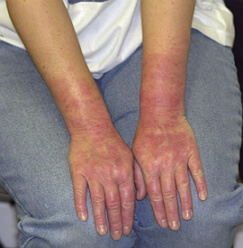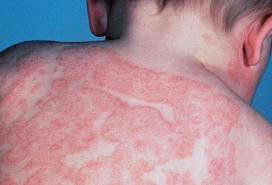Allergy to latex
 Allergy to latex - an allergic reaction to the natural rubber latex produced from the juice of the rubber tree. To be more precise, the allergy develops into some proteins that are part of natural latex. In people who are allergic to latex people, the body mistakenly takes this component for an aggressive alien substance and begins to fight it by developing various manifestations of an allergic nature.
Allergy to latex - an allergic reaction to the natural rubber latex produced from the juice of the rubber tree. To be more precise, the allergy develops into some proteins that are part of natural latex. In people who are allergic to latex people, the body mistakenly takes this component for an aggressive alien substance and begins to fight it by developing various manifestations of an allergic nature.
Latex allergy usually causes reactions that are characteristic of all allergic diseases, starting from a common cold and ending with a serious enough life-threatening anaphylactic shock. Determine the presence of allergies to this component, as well as find out the possible attitude towards the risk group, in the state only a qualified allergist.
most common source of allergies of this type are conventional medical and household rubber gloves, but latex is contained in other rubber products - balloons, condoms, some medical devices, etc.
In addition to health care workers at risk of latex allergy include people:.
• With deformed urinary tract or bladder
• With defective bone marrow cells
• With a urinary catheter with a rubber tip
• The survivors are numerouse operations
• C intolerance chestnuts, kiwis, bananas and avocado
• Patients with eczema and / or asthma
• Frequently using
condoms • Associated with industrial production of rubber articles
exact cause allergic reactions containing latex products until the end and is not defined, However, numerous observations have shown that repeated long-term contacts with rubber and latex can provoke quite healthy people the development of allergic symptoms. According to statistics, various forms of allergies to latex are observed in about 8% of housewives and 15% of health workers
Latex allergy -
symptoms main way latex contact with the human body: when you use latex gloves through the skin, inhaled, covering rubber gloves powder throughMucous membranes( rectum, genitalia, mouth, eyes), when using rubber-containing instruments during medical manipulations( through the blood).
First of all, the allergic reaction to latex is manifested in the form of contact dermatitis with symptoms such as damage, burning, itching and dry skin. Such a reaction develops due to the effect of various chemical substances contained in rubber gloves. Contact dermatitis is considered a non-hazardous reaction and refers to non-allergic skin reactions.
But when the body reacts to the substances and components used in the manufacture of latex, allergic contact dermatitis develops, manifested by dryness, itching, flaking and burning of the skin. This allergic reaction manifests itself much more sharply, is prone to spread over large enough areas of the body and lasts longer. Also, a serious reaction to latex may manifest as rhinitis with the symptoms of hay fever and cause colic, conjunctivitis, a highly itchy rash. In rare cases, palpitations, lowering of blood pressure, and anaphylactic shock can be observed.
The symptoms of latex allergy vary from person to person and can be manifested as minor rapid reddenings and serious problems in the functioning of the gastrointestinal tract. Fortunately, allergy to latex with serious symptoms is rarely accompanied, but refusal of treatment can lead to rather disastrous consequences.
When diagnosed with an allergy to latex there are cross-allergic reaction to tomatoes, peach, pineapple, mango, melon, fig, chestnut, avocado, papaya, kiwi, bananas, and the fruit of Passiflora.
If you develop any of the above symptoms, you should, without delay, seek medical help from an allergist. A qualified medical professional in the process of preliminary communication will be able to identify the relationship between the development of allergic symptoms and contact with latex. To identify the presence of latex allergy, there are special questionnaires. A so-called "glove test" was widely used based on observation of the reaction after and during contact with latex. In addition, the patient is shown carrying out skin tests with a latex allergen. To clarify the diagnosis, the function of external respiration( reveals latex-induced bronchial asthma), monitoring of PSV, etc. research
Allergy to latex - treatment
In case of latex allergy, the basis of all medical and preventive measures is the exclusion of contact with latex. This applies even to those latex products that some firms position as "hypoallergenic", since with latex allergies, any contact with this substance should be ruled out. Rubber hypoallergenic gloves are best worn by people who contact with latex for certain reasons will be inevitable, but they have not formed latex allergy yet. For those who already have latex allergy, rubber gloves must necessarily be replaced with neopril, nitrile or vinyl. Also, the latex containing medical equipment should be discarded, contact with plasters, disposable syringes and enemas should be avoided. Concerning condoms, latex-free analogs exist, but if they can not be obtained, the method of contraception should be completely different.
Allergy to latex implies the exclusion of contact absolutely with all products made of rubber and latex( gaskets in plumbing, car tires, etc.).Latex should be absent both in everyday life and in clothing. Even balloons to a child are strictly forbidden to inflate. Single cases were described where the allergic reaction developed for food prepared with rubber gloves, so it is better to refuse from visits to ready-to-eat enterprises in case of severe allergy to latex. I also want to say a few words about the synthepone that has already entered our life for a long time. So, for the binding of its fibers, a latex-containing substance is always used, therefore, during the choice of bedding, a filler of hollow polyester fiber
should be preferred. Medication for allergy to latex
Treatment of this allergic reaction with medicines must necessarily be combined with measures aimed at preventing possibleContact with the allergen. When treating allergies with antihistamines, preference is given not to drowsiness and not reducing the reaction speed to such modern long-acting drugs as Erius, Telfast, Semprex, Zirtek, Claritin. In the case of using antihistamines of the third generation at least one hour before possible contact with latex, in patients with mild forms of this type of allergy, the symptomatology was extremely insignificant or not manifested at all. Treatment of moderate and severe forms of allergy to latex includes a triad of drugs: glucocorticoid and antihistamine hormones, adrenaline.
The most severe manifestation of this type of allergic reaction is anaphylactic shock, which implies immediate anti-shock measures. Therefore, in severe allergic reactions, patients are shown wearing a special medical bracelet, which will indicate that he has an allergy to latex.



